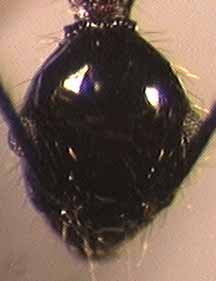
Formicidae, Hymenoptera, Insecta, Arthropoda, Animalia
|
|
Range
Costa Rica: Atlantic and Pacific slopes from Meseta Central northward.
Identification
Minor worker: head length 0.79mm, head width 0.61mm, scape length 1.07mm, Webers length 1.03mm (n=1). Head with vertex collar present but narrow; promesonotal and metanotal grooves well impressed; propodeal spines of moderate length to long; face largely smooth and shiny; pronotum smooth and shiny; face and pronotum occasionally with patches of faint punctation; mesonotum foveolate on sides, and smooth to faintly foveolate dorsally; propodeum with sides and basal face uniformly foveolate; gaster smooth and shiny; pilosity moderately long, flexuous; color dark brown.
Major worker: head length 1.27mm, head width 1.18mm, scape length 1.08mm (n=1). Most of face punctatorugose, an abrupt transition to smooth and shiny at the posteriormost margin of vertex lobes, ventral surface of vertex lobes smooth and shiny; strength of face sculpture varies, may be almost uniformly strongly foveolate, or punctatorugose, or more faintly punctatorugose, or faintly punctatorugose with scattered shiny patches; hypostomal margin with pair of widely-spaced teeth, each tooth sharp and needle-like, located near small recessed tooth flanking mandible, variable in size and may be reduced to small tubercles; head, mesosoma, and gaster covered with abundant, long, erect setae, including abundant erect setae projecting from sides of head in face view.
Similar species: susannae, kukrana, cocciphaga.
Natural History
This common species occurs in wet to moist forest habitats. It occurs on the ground and in the canopy, and has been observed foraging dirunally and nocturnally. It recruits to baits on the forest floor. It has been observed nesting under dead wood on the ground, and in the low arboreal zone. The arboreal nests have been in cavities or under accreted soil.
Selected Records
Collections from La Selva (Winkler samples, baits, occasionally in fogging samples), Monteverde, Penas Blancas, Braulio Carrillo from 50-1300m, Estacion Maritza and Pitilla, both at 600m in Guanacaste Conservation Area, Carara at 500m.
La Selva: nest in dead wood on the ground (Chris Thompson study).
Braulio Carrillo National Park at 500m: primary wet forest; night collecting. A nest was in a hollow vertical stalk that had been cut off at 1m height. The workers did not appear to be foraging, just milling about the nest entrance.
Penas Blancas Valley: abandoned cabin, recruiting in large numbers to old manteca (shortening).
Penas Blancas Valley: second growth at the edge of river; nest with queen in hollow live stem.
Monteverde: in pastures surrounded by cloudforest, just west of the divide, three nests were observed in and under rotten wood on the ground.
Carara at 500m near Bijagual: tall wet forest. A nest of accreted soil was on the side of a tree trunk, about 1m high. Miscellaneous epiphytes (a Piper, an aroid, other seedlings) were sprouting from the nest.
Guanacaste Conservation Area (Cerro Cacao): forest/pasture edge; nest in dead wood on ground.
Comments
Pheidole indagatrix appears very similar to P. obscurior Forel 1886, judging from the line drawings in Wilson (2003). The type locality of Pheidole obscurior is Rio de Janeiro, Brazil. Kempf (1972) gave a range for obscurior that extended from Guatemala to Argentina. Wilson was able to personally verify specimens that matched his concept of obscurior from southeastern Brazil and Meta, Colombia. Pheidole indagatrix is a common and widespread species in Costa Rica. It could be that Kempf's concept of obscurior would match what Wilson identified as a new species indagatrix.
Literature Cited
Kempf, W. W. 1972. Catalogo abreviado das formigas da regiao Neotropical. Studia Entomologica 15:3-344.
Wilson, E. O. 2003. Pheidole in the New World: A Dominant, Hyperdiverse Ant Genus. Harvard University Press, Cambridge, Mass
John T. Longino, The Evergreen State College, Olympia WA 98505 USA. longinoj@evergreen.edu
Stefan Cover, Museum of Comparative Zoology, Harvard University, Cambridge MA 02138 USA. scover@oeb.harvard.edu